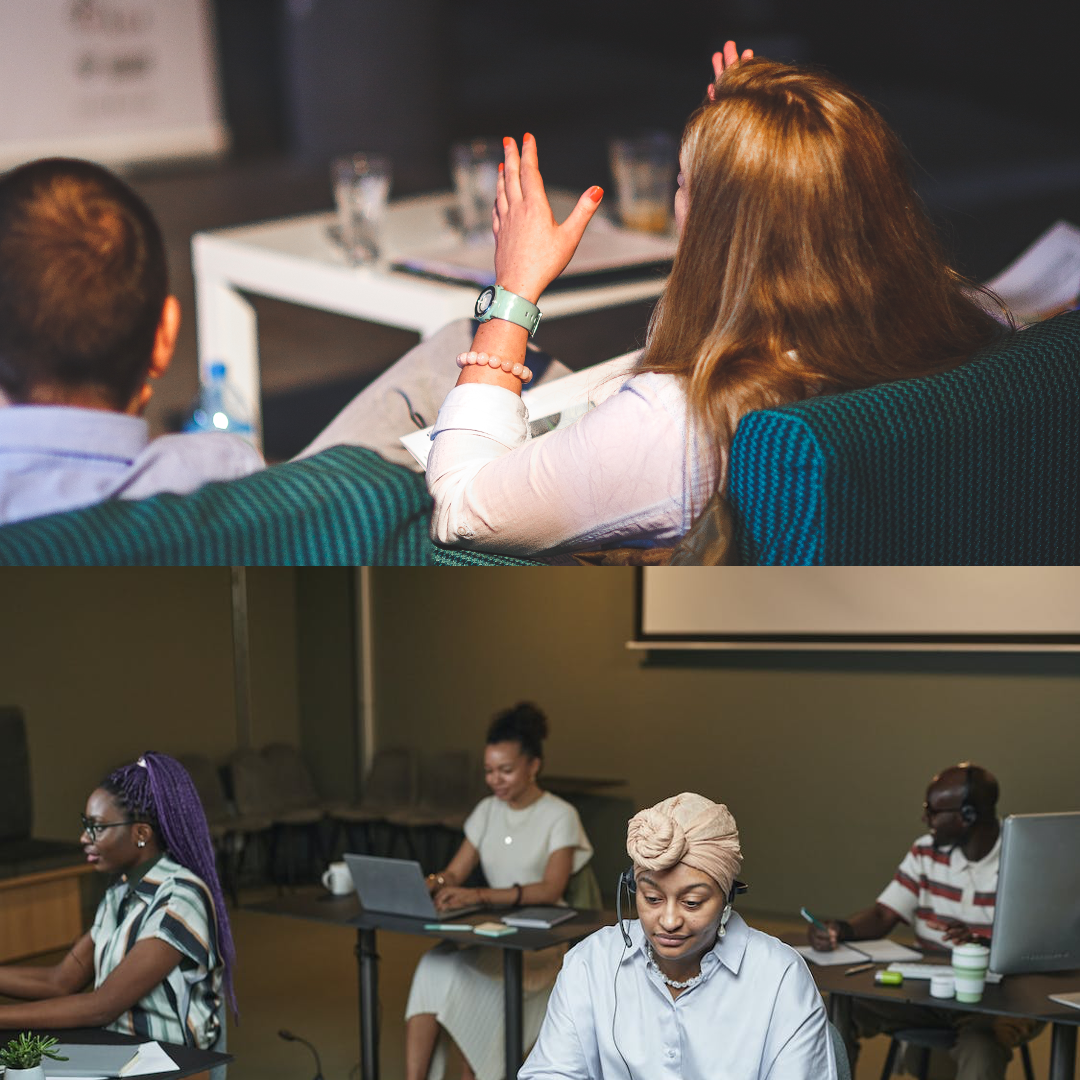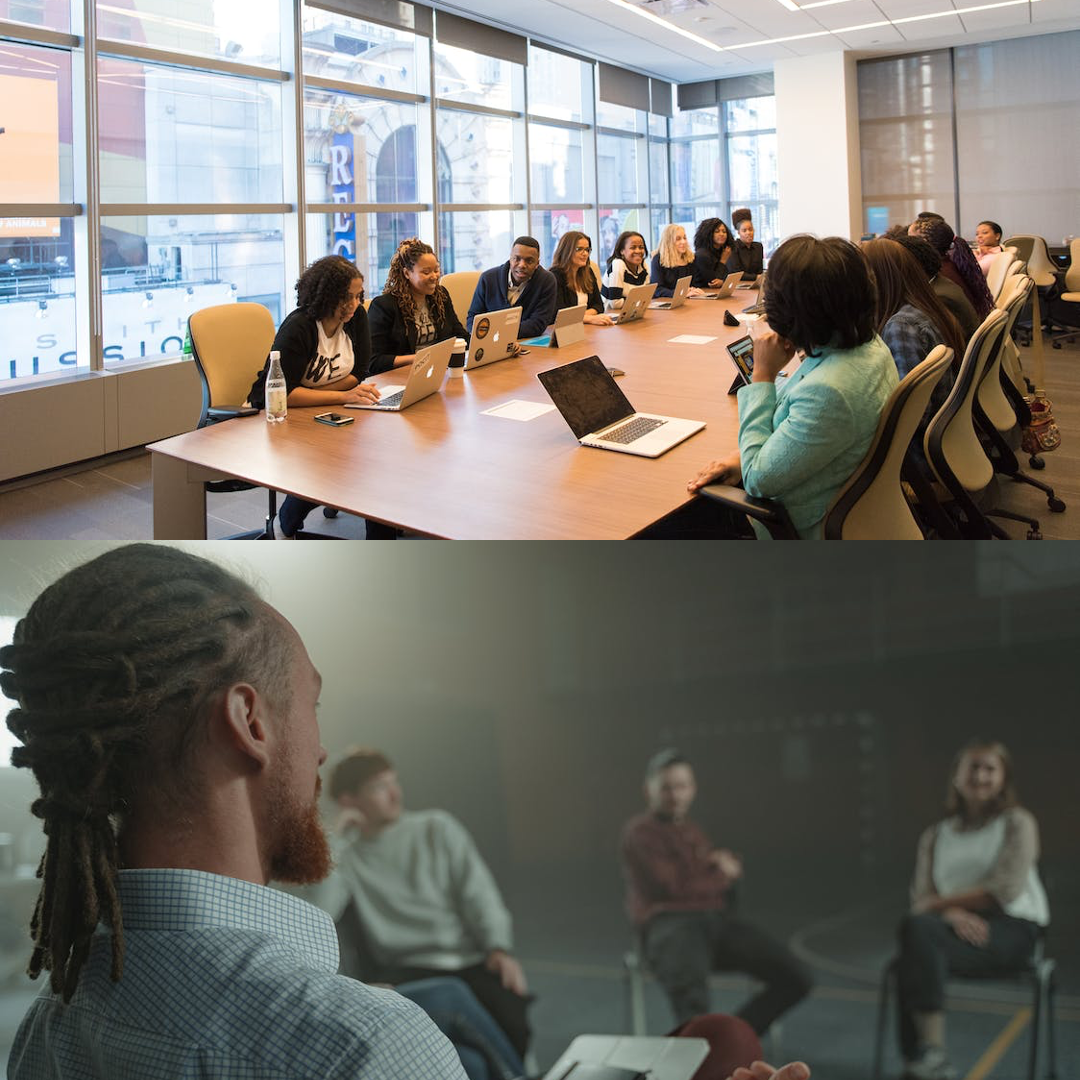The impact of context on conversation, and how to have more productive meetings
Table of Contents
AGENDAPARTICIPATION
LOCATION AND LAYOUT
CONDUCT
RESOURCES
FOLLOW-UP
ABOUT THE AUTHOR
It should not be a surprise that a meeting without a clear purpose or agenda is likely to be a waste of time. What may be surprising is the sheer number of factors, some straight-forward, some subtle that can influence attendance, participation, performance and productivity.
AGENDA
GoTop
Let’s start with the agenda, since that is straight-forward and so frequently done poorly. A good agenda should answer Who, What, When, Where, How and Why. Everyone has their own style, some value bullet point brevity others a little context and introduction.

These are the elements I consider when sending a meeting invitation.
Date/Time
The date and time will have an impact on participation and engagement
Purpose
The aim of the meeting is to… It is useful to be clear on outputs, outcomes, is this a discussion or a decision. Who and what will be impacted by this meeting.
Preparation
Perhaps indicate what to bring, read, or do before the meeting. Perhaps refer to previous actions or decisions or reports, so that people attend prepared and able to make a contribution.
Agenda
We plan to cover the following items… Be prepared on topics and issues. Who will be speaking at the meeting. I have often found a list is really useful to focus on key issues and manage time.
Item – Topic – Speaker – Time
No 1 – Discuss ABC Interface Requirements – Leslie Jones – 20 mins
No 2 – Agree ABC Development Team – Sam Johari – 10 mins
Attendance
Think about who is Responsible, Accountable, Consulted, Informed. Who needs to be involved now or later, and which teams/departments need to be represented. Equally avoid disruptive, destabilising or distracting attendance which may stifle contribution or take things off-course.
Location
As much as the meeting may about practical discussion, design, decision, delivery to get things done, it is also useful to nurture a thinking and collaborative and creative approach that may be encouraged by location, and room lay-out. An interview across a table in a windowless office is inevitably going to have a different impact on thinking, feeling and contribute to a circle of chairs with a window to nature. Select what is appropriate to the purpose and participants.
PARTICIPATION
GoTop
To expand upon the preparation (discussed above) think about how the meeting is run.
The perfect group is somewhere between 5 and 10. Beyond that number it can sub-divide and be harder to manage communicate and coordinate.
Consider if there is a chairperson or is it facilitated and if so by whom. Should facilitation be by an expert or someone who is independent and neutral. How are people invited to speak and do they all get equal opportunity? As a coach / mentor / mediator I am a fan of the Ten Components of a Thinking Environment.

Ten Components of a Thinking Environment
1. Attention: listening with palpable respect and genuine interest, and without interruption
2. Equality: treating each other as thinking peers; giving equal turns and attention; keeping boundaries and agreements
3. Ease: offering freedom from internal rush or urgency
4. Appreciation: practising a 5:1 ratio of appreciation to challenge
5. Encouragement: giving courage to go to the cutting edge of ideas by moving beyond internal competition
6. Feelings: allowing sufficient emotional release to restore thinking
7. Information: supplying the facts; recognising social context; dismantling denial
8. Difference: welcoming diverse group identities and diversity of thinking
9. Incisive Questions: removing untrue assumptions that limit our ability to think for ourselves well
10. Place: creating a physical environment that says back to people, ‘You matter’.

LOCATION AND LAYOUT
GoTop
on-premises
To expand upon the location (discussed above) the setting and room arrangement as well as the surroundings can have a profound affect. The use of maps, photos, posters or the presence of flip-charts, white-boards and post-it notes all have an effect upon thinking, feeling and participation, even before they are used.
Having the meeting on the top floor or a hotel or in the basement of a office block sends message to the participants about how you value them, and the items being discussed. Even the hosting including availability of tea, coffee may be factors.

As an example, I know one organisation which offered every employee 30mins “time-off” and a free coffee and bacon roll (or alternative), in order to complete the staff survey. It should not be a surprise that this gesture both improved the number of responses and had an impact on the outcome of the survey.
on-line
A lot has been written about conducting meetings on-line using zoom, teams, skype, google or other tools. My simple tips are…
1. Sitting can be stagnating. Keep meetings short, active and engaging. Perhaps use ‘break-out’ rooms, chat or other on-line tools. I have expanded a bit on this below with a list of useful on-line resources.
2. Vary the content with visuals and questions so that people are not staring at the same person or image. If this is a long meeting or workshop, and really cannot be split into shorter productive meetings, consider breaks every 30 – 40 min.
3. Try to encourage people to keep the camera on, but respect the need for occasional breaks from the face to face staring and emotional fatigue that comes from on-line meetings.
Beyond these perhaps search on-line for further tips.
CONDUCT
GoTop
To expand upon the Ten Components of a Thinking Environment (discussed above) I should say “What we tolerate is what we get” – if we tolerate lateness, interruptions, phone calls, or people tapping on laptops then that is what we will get. Even the presence of a phone in the hand or on the table has an impact on concentration and participation.
Very often workshops or team might agree self-imposed rules. The list below are from the 2022 masters rowing programme. Both Men’s and Women’s Masters crews won gold.
Rules of the Boat
1. We will respect each other and watch each other’s backs
2. We will train hard but sensibly and responsibly to drive performance and avoid injury
3. We will be honest, but fair with each other
4. We will be on-time
5. We will communicate openly and often
6. We will put aside any personal preferences to make the boat go faster
7. We will debrief after every race
8. We will maintain a log of training and Personal Best milestones which we will be available for everyone in the team to see
9. We will always wear team kit
10. After every session every team-member will shake hands, ritual is important to trust
11. We will respect the boat
12. We will be professional when racing: We will respect our opponents and be magnanimous in victory and gracious in defeat.
13. We will request any changes to be made to boat set-up the day before a race and not on race day
14. These rules (and any that are added, amended or deleted) will be agreed and followed by us all.
RESOURCES
GoTop
To expand upon white board, flip charts and post-it notes (discussed above) it is useful to have the following in good supply, just in case.
The following are useful on-premises resources
Pens, pencils and paper
Flip charts and markers
White boards and markers
Post-it notes
Brown roll of wrapping paper (Useful as a background or canvas for process maps)
Camera (I like to photo the Flip charts, process maps, etc)
The following are useful on-line resources
Online whiteboards: Miro, Mural, Stormboard, FigJam
Meeting planning: SessionLab, Google Sheets
Virtual facilitation platforms: Stormz, Butter, Thing.Online, Toasty.ai, Klaxoon
Virtual space tools: Spatial, Gather, Welo
Engagement tools: Mentimeter, Slido, Kahoot
Video conferencing: Zoom, Whereby, Skype, Google Meet, Big Marker
Survey tools: Google Forms, Typeform, SurveyMonkey
File storage and document sharing: DropBox, Google Drive, OneDrive, Box
Online communication tools: Slack, MS Teams, Discord, Chanty
Online Learning Platforms: Padlet, LearnWorlds, Nearpod, Teachable
Task management: Trello, Todoist, Asana, Notion
Note-taking apps: Evernote, OneNote, Google Drive & Docs
Online design tools: Canva, Figma, Invision
FOLLOW-UP
GoTop
Leaving a positive and lasting impression is important so how we end and when you follow-up and follow-through will be important to the value of the meeting.
It may be useful to summarise decisions and actions in the meeting, or even better to get each participant to confirm what they will do as a result of the meeting. People have a much stronger commitment to action if they confirmed the undertaking rather than just heard the request.
Generally the follow-up and follow-through will come in the form of a list of actions, a record of the meeting or formal minutes.
Sometimes the document is an aide-mémoire to people who attended and can therefore be very brief, simply as a prompt for their recollection.
Sometimes the document is an formal record of a discussion and/or decision. It may be used to communicate, collaborate or co-ordinate with others who have not been at the meeting or possibly as an audit or other key record of governance: for example evidencing the process and participation in decision making.
Sometimes the document will we very formal, perhaps for regulatory, disciplinary or administrative purposes like a Board Meeting, where there may be a prescribed format or legal necessity.
It is important to get this right, including the possibility of two versions, if there are indeed two audiences with different needs and expectations for the meeting. Clearly if you take this approach the variance may be in format, content, style but not in substance: perhaps a bullet summary for the board and more detail for the participants.
These are the elements I consider when recording a meeting.
Date/Time/Location
Purpose/ Context
Attendance
Discussion
This may be a simple list of decisions and actions and their owners and target-date for action, or other key elements like price or success criteria. To help context you may include a summary of the key points, risks, issues or alternatives that were considered prior to agreeing the outcome and outputs. In my experience this additional information is useful as an audit to who is Responsible, Accountable, Consulted, Informed and may be important as evidence of process, or basis of decision should there be a need to recourse to the discussion.
ABOUT THE AUTHOR
GoTop
I have more than 30 years’ experience delivering projects, programme and change and have gathered many tools, templates and tips for every type and scale of project. I love drinking coffee and exchanging ideas, so if you need anything please feel free to message me.
Follow me on a journey exploring new ideas and opportunities @timhjrogers #timhjrogers
Tim HJ Rogers
ICF Trained Coach, IoD Business Mentor, Mediator
MBA Management Consultant + Change Practitioner
Mob 447797762051 Tim@ThinkingFeelingBeing.com
FOLLOW *THINKING FEELING BEING* https://www.linkedin.com/company/thinkingfeelingbeing
Helping people and organisations achieve their goals: We facilitate and support the thinking, feeling and action needed to resolve and move forward.
#ambition #awareness #being #career #careercoach #careergoals #ceo #coach #coaching #empower #empowerment #enlightenment #executive #executivecoach #executivecoaching #facilitation #feeling #goals #gratitude #growthmindset #icfcoach #lawofattraction #leader #leaders #leadership #leadershipcoach #leadershipcoaching #leadershipdevelopment #leadership #lifelessons #mediation #mentor #mindfulness #mindset #motivation #motivationalspeaker #personaldevelopment #personalgrowth #philosophy #productivity #psychology #purpose #relationshipcoach #selfawareness #selfcare #selfconfidence #selfdevelopment #selfesteem #selfgrowth #selfimprovement #selfworth #success #successcoach #thinking #training #workshops
